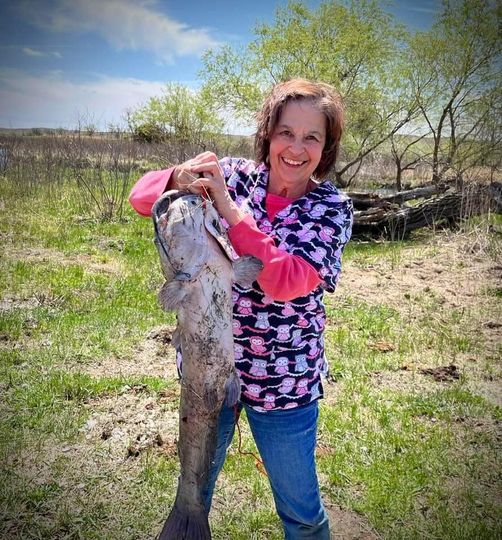I threw my only pole, an ultra-light with 6 pound test line into the back of my SUV along with my fishing box. My sister had called. “The turkey hunter has caught a couple of nice catfish out of the hole by the culverts,” she reported. “You might want to bring your pole.”
I was headed to the home ranch for a three night visit. May is my favorite time to go. The hills are green, the new calves are cute and spunky, and the deer flies have not arrived yet.
Back when I was growing up on the ranch, I fished for carp in the Calamus River that winds quietly through the meadows. They were big and feisty and Mom would fry them up. It was a meal we didn’t have to buy so “catch and release” was not in our vocabulary. I honestly don’t believe I became familiar with that phrase until after I was married. I was always made to feel that I had contributed greatly by providing the supper’s main dish. Catfish and bullheads were not available in the Calamus when I fished it as a kid. These species didn’t migrate upstream into our territory until the Calamus Dam (now known as the Virginia Smith Dam) was erected at Burwell, Nebraska in 1986. By this time, I was living in Buffalo, Wyoming – married with two small boys.
There are three culverts that cross under the road, just south of the house I grew up in. They replaced the old wooden bridge that was there when we first moved to the ranch in 1965. The force of the water through these culverts has carved out a nice big hole for the fish to hang in and a pool where the great nieces and nephews swim on sweltering summer days.
I rigged up my pole just the way Caleb, my son, had told me – a treble hook with some beef liver encased in a small nylon bag fashioned from a pair of panty-hose. This keeps the soft, pliable liver contained and on the hook.
I stepped out onto the middle culvert. I was pleasantly surprised that the trick with the panty-hose seemed to work well. After several casts the liver was still securely in place. Even though the Calamus is generally an easy going stream, the current is strong by these culverts. It pays to keep alert so your line doesn’t get sucked into one of the large rotund structures.
My heart rate jumped when I felt the strong tug on the fourth cast. It soared higher when – whatever it was – began pulling my 6 pound line back against the current. I watched in amazement as my open reel began to spin out of control. It seemed much like the time I hit black ice in my Ford Ranger. My light pole and reel – perfect for South Dakota trout – was going to be no match for this guy. I had little confidence that I would actually land this fish, but until he snapped the line – I was playing.
Since my equipment was no match, it seemed my best bet would be to allow him to tire out before I tried to maneuver him towards the shore. I was fairly certain the hook was secure since he hadn’t spit it out yet. Maybe, just maybe….if he would lose the fight in him…I could ease him up to the shore.
My plan was progressing forward. As he tired, I could reel him in closer in increments of inches at a time. Finally, I brought the exhausted fish so close that I could tighten my line so his huge head was above the water and lying on the sand. Keeping the line taut, I scrambled – well, not exactly scrambled – down the three foot vertical bank. Had someone been with me, they would have likely said I cautiously eased down the embankment. (It must have been my heart that was scrambling.)
Oh my…here I was! It looked like I was going to get this fish ashore! But, just as I pulled on the line a bit more to bring his whole body out of the water, the line snapped. One flap of his tail and he would be gone. Thanks to my nursing career, my critical thinking skills kicked in. I reached down and sank the fingers on each hand into his gills and pulled him up the remaining way up out of the water. If I could keep my fingers anchored where they were, I would have the biggest fish I had ever caught. Keeping my fingers in his gills wouldn’t be a problem but striving to climb back up the three foot vertical bank in that position would be.
I’m not sure how I managed to do it as I really do not remember the minutes that occurred from the shoreline to the road. I do know the whole experience was an adrenaline rush. That may have helped propel this 68 year old grandma vertically upward without the use of hands.
Sometimes, our own strength isn’t enough to do what’s placed in front of us. During these times we can rely upon a supernatural strength that we have access to as Christians. Philippians 4:13 tells us that we can do all things through Him who strengthens us. It’s a great verse to put in our back pockets for we never know when we will be faced with a situation that requires more strength than we have on our own.
That catfish was mighty fun to catch, but the big old thing was nothing to write home about when it came to supper. I would have just as soon had some of that carp Mom used to fry up.
Until next time, keep on readin’ and I’ll keep on writin’.


A friend
I’m amazed every time I look at the picture of you and that whale of a catfish. You were blessed from above that day, along with the adrenaline it took to climb the bank. Keep on fishin and writin, you’re good at both.
delilalumbardy@gmail.com
Thank you for the encouragement.
Anonymous
OH MY GOODNESS! That thing is HUGE, DeLila!!! I cannot imagine that you could even reel it in! Good job! Did you guys really cook it and eat it?
delilalumbardy@gmail.com
Cleaning it was almost as big a job as catching it – I had to confer with youtube several times. LOL Yes, we did attempt to eat it, but the flavor was not very good. I’m assuming because it was big and fatty.